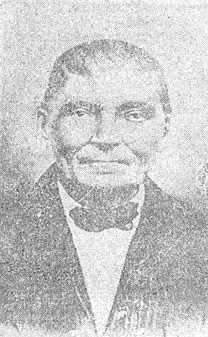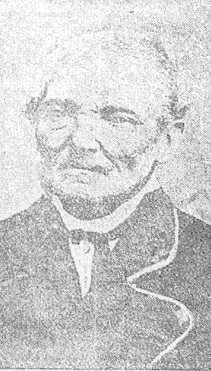|
William
Bartlett of this city has gathered, mostly from personal reminiscences,
the life stories of one of the unsung heroes of the Chippewa Valley, Jean
Brunet (1791-1877). Little is known about the man except what a few persons
remember of him, although is untiring work and his very evident belief
in the future of this part of Wisconsin has earned for him great credit
in the early development of the country. Brunet was a Frenchman of the
educated class, member of the territorial legislature in 1837, built a
sawmill in Chippewa Falls and for several years operated a stopping place
for woods and river men near the site of the present town of Cornell.
Mr.
Bartlett's efforts have resulted in an absorbing story of this settler,
who, though he earned much, gave it all away, and died with little but
the home he had lived in. Only ten references are to be found concerning
him in the publications of the State Historical Society, but the following
article, written especially for The Leader, contains interesting incidents
and data from the memory of Mrs. Gustave Robert, whose father, Francis
Gauthier, was the protégé of Brunet:
(By
W. W. Bartlett)
If
the question were asked who was the most noteworthy person in the early
history of the Chippewa Valley probably the first place would be given
to the name of Jean Brunet. This being the case, there is nothing approaching
a biography of the man had never been recorded. In the entire list of
publications of the Wisconsin State Historical Society there is to be
found only some ten references, mostly brief and disconnected, pertaining
to this interesting character. Other brief mentions are made of him in
some of the more local historical works, but taken altogether they furnish
nothing like a complete life history.
In
the year of 1881, "A History of Northern Wisconsin" was published by the
Western Historical Society, A.T. Andreas of Chicago proprietor. In that
book the writer of the chapter on the general history of the Chippewa
Country makes brief mention of Brunet. This writer seems to have taken
considerable pains to verify his statements, and as Jean Brunet had been
dead only a few years when the chapter was written probably his statements
are generally correct. He states that Jean Brunet was born in France,
date not given, and migrated to St. Louis in 1818, where he was employed
by Chouteau Brothers, by whom he was sent to Prairie du Chein in 1820.
That place having been fixed as the headquarters of the American Fur Company,
also as a military post by the United States Government, occupying the
fort used by the British in the years 1813-1815. There is a story to the
effect that a French voyageur by the name of Rollette acted as pilot in
conducting an English expedition from Green Bay, by way of the Fox and
Wisconsin Rivers, to Prairie du Chien, and for that service he received
twenty thousand dollars in gold. It is said the Jean Brunet afterwards
married a sister of this man Rollette.
Preeminent
in Prairie du Chein
There is evidence to show that Brunet was a personage of some standing
in Prairie du Chien. In Volume 7, page 290, of the Wisconsin Historical
Society Collection, a Mr. Beochard makes this statement: "Dr. Moses Meeker,
in his narrative in the sixth volume of the collection of the State Historical
Society has said that Colonel James Johnson came to Galena in 1822. I
desire to set this error right. I was in that year in Prairie du Chein,
running a keelboat on the Mississippi for Jean Brunet and one Disbrow.
Judge
James H. Lockwood of Prairie du Chien, in Volume 2 Page 161, relating
troubles with the Indians has the following to say of Brunet" "I went
to my house and found it w as vacant, and went to the old village, where
I found my family and most of the inhabitants of the Prairie, assembled
at the house of Jean Brunet, who kept a tavern. Mr. Brunet, had a quantity
of square timber about him and the people proposed building a breast works
with it." On page 164, it continues, "Captain McNair put in command Joseph
Brisbois, lieutenant, and Jean Brunet, ensign, both duly commissioned
by the governor." On page 172 Judge Lockwood says, "Sometime in 1827 or
28 the chief justice of the county and of associate justice having removed
from the country, I presume applications were made to Governor Cass. I
do not know, I was absent from the last of July 1827 to the summer of
1829 and Joseph Rollette was appointed chief judge and Jean Brunet, associate
justice."
On
page 259 of the same volume we find a record of Jean Brunet and seven
others presenting a double barrel gun to General Dodge, with a letter
expressing their appreciation of his services.
In
Grignon's "Recollections," Volume 3 page 295, under the date of 1832,
he records the following, "We stopped at Brunet's Ferry on the Wisconsin,
etc."
Made
a Member of Legislature. Greater
honor came to Brunet when, in 1837, he became a member of the territorial
legislature, succeeding Judge James H. Lockwood already mentioned. We
find Brunet again a member in 1838.
Quoting
again from the Chippewa County chapter of the "History of Northern Wisconsin,"
page 193, we read, "A treaty was held with the Indians at Fort Snelling
on July 29, 1837. Governor Dodge representing the United States, while
"Hole in the Day" with forty-seven others, represented the Chippewas.
A large tract of territory was then added to the United States, which
included a part of the Chippewa Valley, and extended a half days march
below the falls.
"Immediately
after these lands came into the possession of the United States a number
of fur company's agents, including H.L. Dousman, General H.A. Sibley,
Colonel Aiken and Lyman Warren, fitted out an expedition at Prairie du
Chien to erect a sawmill at the falls of the Chippewa. This enterprise
was put in charge of Jean Brunet, who engaged as operators, boatmen, ax
men, loggers and mechanics, for the most part French Canadian voyageurs
and others, formerly in the employ of the fur company, together with a
number of the half-breeds who had of course been raised on the frontier.
The building of the mill under Brunet proved a more tedious process that
supposed, the difficulties of handling the rock to be excavated has been
very much underestimated its hardness exceeded their expectation and the
contractors were unable to complete the race for the original stipulation."
Among the employees who came with Brunet was a Mr. Stacy, Jim Taylor,
and a Francis Gonthier, who remained in Brunet's employ for forty-one
years, until the latter's death. (Note: the name of Gonthier should be
Gauthier. More will be said of him later).
Visits Chippewa
Valley in 1832
From the above statement
the date of the beginning of sawmill operations at the falls would be
1838. That is generally incorrect. The generally accepted date is 1836,
and it is said that Jean Brunet had made a visit to the Chippewa Valley
four years, earlier, in 1832.
The
brief record above appears to be about all concerning Jean Brunet to be
found on the printed page. Thomas Randall, in his "History of the Chippewa
Valley," has something to say of Brunet, but nothing that would add materially
to what has already been quoted. Fortunately we are not left entirely
to what has been recorded in books. There are still people living who
knew Jean Brunet personally and whose recollections are of much interest
and value in throwing light on the life of this historic character.
The
mill-building venture at the falls did not prove a success under the leadership
of Jean Brunet and the work soon passed into other hands. Whether or not
he returned to Prairie du Chien we do not know, but in any case the attractions
of the Chippewa Valley were to great for him to resist and at an early
date, just how early we do not know, he built a cabin on the west bank
of the Chippewa River about twenty-five miles above Chippewa Falls, at
the foot of a smaller falls, which took his name, and where he spent the
remainder of his life. For some years he carried on the fur trade and
bartered with the Indians. As the lumbering operations increased and the
fur trade grew less he built a more commodious dwelling, and kept a stopping
place for the accommodations of loggers, river men, and others passing
to and from the lumbering regions further up the Chippewa River and its
tributaries. Of all the stopping places on the Chippewa River that of
Jean Brunet's was best and most favorably known.
Treats
Gauthier as Son
Mention has been made of Francis Gauthier, who came on the Chippewa River
with Brunet and who remained so many years in his employ. Then Brunet
built his cabin at what was later known as Brunet Falls, now known as
Cornell, Francis Gauthier went with him. He received no regular wages,
but was treated as a son. As years passed he married and brought up his
family in the Brunet home and after Brunet's death the courts awarded
to Gauthier what property was left by Brunet.
Persons
are still living who knew Francis Gauthier recall him as a very interesting
man and one who was generally highly esteemed. He was much more a woodsman
and explorer than was Brunet and he with a Batiste Denige, who was employed
by Brunet, made many long canoe trips on the upper Chippewa and its tributaries.
Some
months ago a diary account of a trip up the Chippewa River, in the spring
of 1868, by C.H. Cooke of Mondovi and two other companions appeared in
The Leader and The Telegram. Mr. Cooke describes a visit to the Brunet
home. The whole diary account was very interesting and constitutes a valuable
addition to the local history material of the Chippewa Valley, but Mr.
Cooke was considerably in error in regard to the family relations of the
old fur trader and the stopping place proprietor. The error was a natural
one and does not detract from the general accuracy of his narrative.
Gauthier's
Daughters Lived at Brunet's
Mr. Cooke had considerable to say concerning the three attractive young
women he saw in the Brunet home and whom he understood to be daughters
of Jean Brunet by a Chippewa wife. Brunet's wife, who had died some ten
years before Mr. Cooke's visit, was pure French and they had no children.
The three girls referred to were daughters of the Francis Gauthier already
mentioned. Gauthier's wife was of part French and part Chippewa blood.
Two of these girls are no longer young and two younger brothers are still
living. All are in comfortable circumstances and enjoying the benefits
of the advanced civilization, which to a peculiar degree they have witnessed
in their own lives. The second oldest of the three girls seen by Mr. Cooke
now lives in Holcombe, Wisconsin. Her name is Mrs. Gustave Robert. Her
entire life has been spent within five or six miles of her birth place
in the old Brunet cabin.
A
recent visit to her pleasant home found her and her daughter. Mrs. W.
Ralph Wanner deep in Red Cross activities, her daughter being the local
head in that work.
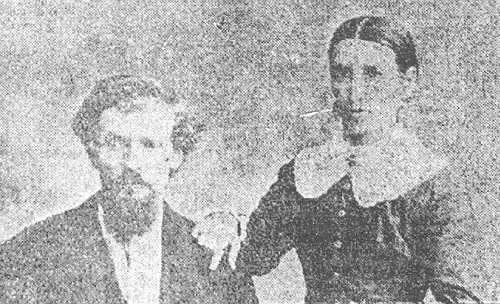
Daughter
of Brunet's Aide and Her Husband
Mr. & Mrs. Gustave (Josephine) Robert, as they appeared in 1876.
They have since lived within a few miles of the site of Brunet's old stopping
place.
Mrs.
Robert is in excellent health for her years and her mind is a storehouse
of recollections of pioneering days on the Chippewa River. Like many others
in those early days she had no educational advantages but she speaks French,
English and Chippewa fluently and is generally informed as to the events
of the day. She is an expert needlewoman, and her handiwork, largely of
her own design has carried off prizes at county and community fairs. She
also takes justifiable pride in her excellent garden. Besides Mrs. Wanner,
she has several other children living near her. With the aid of her daughter,
Mrs. Wanner, we have been able to secure from the mother the following
interesting reminiscences.
Mrs.
Robert's Story
"My father, Francis Gauthier, was of Canadian French descent. I do not
know the date of his birth and am not certain whether he was born in Canada
or not. If so, he must have left there when very young, as he was only
a young boy when he began work for Jean Brunet at Prairie du Chein, coming
from San Francisco. Mr. Brunet took a liking to my father and he was one
of the party that came up with Mr. Brunet to build the first mill at Chippewa
Falls, later going with him to what is now Cornell, or Brunet Falls, where
he remained until after Mr. Brunet's death. He received no wages but was
treated as a member of the family.
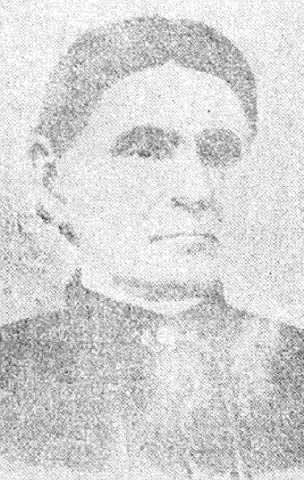
Mrs.
Gauthier (nee Sophie Jandron)
Wife of Francis Gauthier and mother of Mrs. Gustave Robert.
Mrs. Gauthier was of French and Indian ancestry and her home before her
marriage was at Odanah on the Bad River Reservation.
About
1846, my father married my mother, whose name before marriage was Sophie
Jandron. She was from the Odanah Reservation and was of part French and
part Chippewa blood. Six children were born to them in the Brunet home.
One died in infancy. Rose was the oldest of the family. I was second.
Julia was third. The next younger was a boy, Benjamin, and the youngest,
also a boy, named Charles. All five except my oldest sister, Rose, are
still living. Julia, now Mrs. Tomlty, is living in Rhinelander, Wisconsin;
Benjamin owns a large summer resort at Lac du Flambeau, and Charles is
the government interpreter on that reservation.
Brunet
Fine Looking
I do not know when Mr. Brunet was born but as far back as I can remember
he seemed to be an old man. He was a fine looking man, always clean-shaven
and very neat in his personal appearance. Whenever he made a trip to Chippewa
Falls or any place away from home he always wore his fine broadcloth Prince
Albert coat, with white shirt and cravat.
In
his latter years he was in much reduced circumstances, and his clothes
were at times really shabby, but even then he would not wear clothing
that was patched.
I
think Mr. Brunet was from the upper class or aristocracy of France. He
kept his accounts and gave general oversight to his affairs but never
did any manual labor himself. He was always kind and polite. The woods
and river men who stopped at the Brunet place received the usual accommodations
of other such stopping places but when business or professional men came
there they were treated as his guests. He always sat at the head of the
table. These men would be seated near him and Mr. Brunet would serve.
Mr.
Brunet was a deeply religious man, a devout Catholic and very faithful
in all the observances of the church. He never sat down to a table without
saying grace. During those early days the Brunet home was the gathering
place of persons of the Catholic faith in the vicinity for religious instruction
when the traveling priest visited that part of the valley.
First
President of St. John Society
He was the first president of the St. John the Baptist Society in the
Chippewa Valley. At the annual meeting of the Chippewa Lumber and Boom
Company in January 1911, on a motion of William Irvine, general manager,
voted to furnish the funds for the erection of a suitable monument in
the cemetery at Chippewa Falls to the memory of Jean Brunet. The action
was taken in recognition of the fact that Brunet, as already stated had
charge of the first sawmill operated at the Falls.
The
officers of the St. John the Baptist Society were notified of the action
of the lumber company, and in June of that year the monument was erected
under the auspices of that society. The inscription on the monument is
in French. Translated into English it reads as follows:
"To
the Pious Memory of The Valiant Pioneer - Jean Brunet - First President
of the St. John the Baptiste Society of Chippewa Falls, Wisconsin. Born
1791 in Gacogne, France - Died August 20, 1877. Rest in Peace - Builder
of the First Chippewa Falls Sawmill in 1836."
Brunet's
Wife Comes to Chippewa Valley
Mr. Brunet did not bring his wife up from Prairie du Chien until after
he had spent a number of years in the Chippewa Valley but he used to visit
her several times a year. I remember her very well. She took quite a fancy
to me and used to seat me on the table with shears and paper and teach
me to cut out figures. Like Mr. Brunet, she was very devout and spent
much of her time in her room engaged in prayer and religious devotions.
She never did any housework, but used to do a great deal of patchwork
for quilts. She looked older than Mr. Brunet and always wore a close fitting
cap or bonnet. I never saw her without it on. She died shortly after the
Civil War.
One
of my most cherished keepsakes is a French Catholic prayer book, which
she gave me on my second birthday. On the flyleaf she wrote this inscription.
"Donne' le 20 d avril par Madamme Brunet a Josephine Gauthier, age de
2 ans. Riviere des sautuer." In English this would be "Given the 20th
of April (1852) by Madamme Brunet to Josephine Gauthier, age 2 years.
River of the Sauteurs or Chippewa," the word Sauteurs being an early name
for the Chippewa tribe.
Mr.
Brunet was a true friend to the Indians and they always stopped there
when going up or down the river. He never made any charge to them for
meals, but they often brought venison in return. On New Year's Day was
always a great gathering of Indians at the Brunet home and soon after
daylight they would announce their arrival by the firing off of guns.
They would quickly put up their tepees and build their campfires, the
beating of tom toms would be heard and the vicinity of the Brunet home
would soon put on the appearance of an Indian village.
Then
they would come in the house, sit down on the floor, and my mother and
we girls would pass around pans of doughnuts and other eatables, which
we had prepared in advance. All us children could speak Chippewa, as readily
as we could French and much better than we could English.
Old
Abe Goes Down River
I knew most of the chiefs and headmen of the Chippewa tribe and remember
well seeing Ah-Monse, chief of the Flambeau, with his son who captured
Old Abe, the War Eagle, going down the river with the eagle, which they
sold to George McCann. He later sold it in Eau Claire where it was taken
out by a company going into the Civil War. Ah-Monse was short, fat, and
jolly, and had curly hair - the only Indian I ever saw with curly hair.
The
Indians would often camp near the Brunet place. I remember once an Indian
child was very sick and my mother went over to see it, taking me along.
The Indian medicine man was there. He put something that looked like dried
bones in his mouth, chewed them up and spit them into a basin of water
that was on the ground. After going through some motions and examining
the water he said the child would die at sunrise the next morning. It
was customary for the Indians to announce a death among them by firing
a gun several times. The next morning we listened for the guns and just
as the sun rose we heard them. The child had died just as the medicine
man had said.
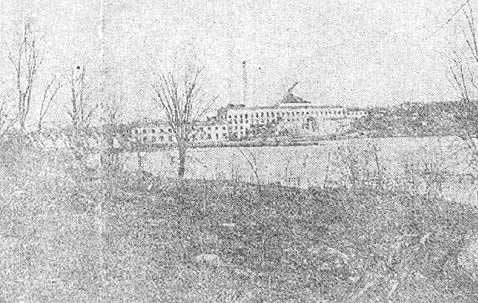
Looking
Up River from the Site Of the Brunet Home
At the Cornel Wood Products Company's Plant
Brunet
Builds Log House
For
a good many years after he came on the Chippewa, Mr. Brunet had only a
one-room log cabin, with curtains around beds. When I was a young girl,
perhaps about twelve years old, he built a long log house facing the river.
The house was torn down many years ago but the foundation can still be
seen, showing the size and the shape of the house. The kitchen was on
the south or down river end, with bedrooms off it for my mother and father
and us children. The next room was a large dining room, which was deeper
than the rest of the rooms and had cupboards clear across the back. The
next was Mr. Brunet's room. The men's room was the upper north end of
the house. A stair led up to the chamber or loft, which extended the full
length of the house and was where the men slept. They did not pass through
Mr. Brunet's room in going to the dining room but had to go outdoors.
My
father looked after the outside work around the Brunet place, while my
mother, who was a good cook and housekeeper with the help of us girls,
took care of the housework. At time when large crews of woodsmen and log
drivers were going and coming we had our hands full. At other time we
did not have so much housework to do, and we would make buckskin mittens
and gloves, also moccasin, plain and beaded.
Raspberries,
blackberries and cranberries were plentiful. Blueberries did not grow
near but the Indians used to bring them to us. Wild plums grew in abundance.
We did not know anything about canning fruit, but we use to dry quite
an amount of berries, also corn. For meat we had mostly salt pork, and
some smoked hams, also plenty of smoke venison. Fish could be had in any
quantity, and partridges and other small game. Mr. Brunet raised a good
many potatoes, also a good supply of vegetables. Our table fare was hearty
but simple. Doughnuts and pies were about the only articles in the pastry
line. The pies were made of dried apples, dried berries or cranberries.
Canoes
Common Means of Travel
We had our simple games and plays. The older folks played cards a great
deal, and sometimes there would be a dance, but I never learned to do
either. I never used a gun until I was married, when my husband taught
me to do some target shooting. We use to fish and all of us were at home
on the water. I could pole or paddle a birch bark canoe either standing
or sitting and there was never any lack of canoes.
The
Indians would start from the headwaters of the Chippewa with their canoes
in the fall hunting and trapping their way down by the time they were
ready to return the river would be frozen over and they would leave their
canoes at the Brunet place making new ones for the next trip. The whole
country was almost unbroken pine forest and one could walk for hours without
seeing the sun, but we never felt afraid to be out in the woods or on
the river alone and were never molested either by Indians or white men.
Of
course we saw a great deal of the early lumbermen and most of them were
fine men. I remember especially Daniel Shaw. He used to spend more time
in the logging camps and on the river than any of the other big lumbermen.
Everyone had a high opinion of Mr. Shaw. Sometimes he would take Mrs.
Shaw with him to visit the lumber camps and they would stop at the Brunet
place. Another fine man that spent a great deal of time at the Brunet
place was Ezra Cornell. He made the Brunet place his headquarters when
he came out from the east to locate lands for the Cornell University.
He was a large, fine looking man and always wore a long full beard. Mr.
O.H. Ingram used to stop there often, also Bill Pond, Pete Legault, Alex
McDonnell, Thad Pound, Ed Rutledge, Dave Sebe, Mike Miles, Seth Pierce
and many others.
Brunet
Fond of Reading
Jean Brunet was fond of reading but did not take any interest in hunting
or fishing or other outdoor sports. Like nearly every one in those days,
he drank intoxicating liquors, but unlike most of the stopping house proprietors,
he did not keep it on sale and seldom had it on the place. He kept a small
stock of staple supplies needed in lumber camps and by the Indians and
the few white residents of that vicinity. He cut a great deal of wild
hay on the marshes, which he sold to loggers; he also raised and sold
a good many oxen.
Mr.
Brunet selected a fine location for his home. His cabin was built on the
west bank of the Chippewa River perhaps eighty rods below the present
Brunet Falls Dam. The site was level and high enough to always be dry.
Below the falls and in front of the Brunet cabin a bend in the river formed
a bay, with very little current. In the side of the bank between the cabin
and the river there was a fine spring, which supplied the house with water.
During
all the early days there were no roads up the river. In the winter supplies
were hauled up on the ice. For all summer or fall travels it was necessary
to use boats. Two kinds of boats were used for this purpose. The earliest
ones used were wooden canoes or dugouts made from a single large pine
log. In later years these were largely replaced by the "Bateaux," large
boats with both ends pointed. A considerable income was received by Mr.
Brunet from the portaging of these boats and their contents around the
falls. The bay below the falls afforded a good place for the boats to
land. From the landing place a road had been graded along the side of
the bank and up to a suitable place in the river above the falls.
Mr.
Brunet had a four-wheeled wagon or cart, the wheels of which were thick
and were made of sections sawed from a large pine log. The contents of
the boat were first hauled around the falls, and then the canoe or bateaux
was loaded on the cart. Mr. Brunet had a regular charge for the boats
but the charge for portaging the contents was made by hundredweight. I
well remember the old cart with the wooden wheels, but he later replaced
it with one having iron wheels.
Brunet
Dies Poor
If Mr. Brunet had not lost so much in bad accounts he would have been
wealthy in his old age. As it was at the time of his death he had nothing
left except the place and the value of that at the time was only a few
hundred dollars. The courts granted this to my father as an offset to
his many years of service without regular pay.
I
have in my possession the old ledger in which Mr. Brunet kept his accounts
from the year of 1862 until the time of his death. A good share of the
accounts were never settled and some of the amounts due Mr. Brunet were
quite large. Mr. Brunet died in August 1877 and was buried in the Catholic
cemetery in Chippewa Falls. My father, Francis Gauthier, died in January
1880. My mother died only ten years ago (1909).
Our
neighbors were few. Across the river from the Brunet place about where
the Cornell Wood Products company mill is now located, there lived a Frenchman
by the name of Batiste Denige. He cultivated a small piece of ground but
most of the time he worked for Mr. Brunet. Another Frenchman by the name
of Beauregard lived not far from Denige's. He worked more or less for
Brunet. For some years Mr. Brunet had in his employ two young Swiss. One
of these, Henry Duvanel married my older sister Rose.
A
few months later, in August 1869, I married the other, whose name was
Gustave Robert. He was a steady, thrifty man and experienced woodsman.
He was a chopper, whose job it was to chop down the pine trees for saw
logs and they received the highest pay of any in the crew. Sometimes he
would contract to chop by the thousand feet a day. I heard him tell me
how many thousand feet he and his partner would chop down but I have forgotten
the figures. He was a good timber cruiser and always acted as guide and
assistant to Ezra Cornell in the locating of pineland for Cornell University.
We
were married in 1869. My husband secured a piece of land about three miles
above the Brunet place, on the opposite side of the river, near the mouth
of the Fisher River, where the pine was very fine and abundant.
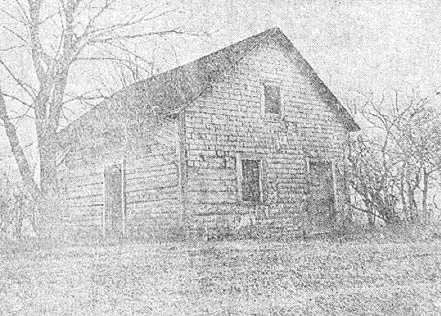
Mrs.
Robert's First Home, a well built log house, shingled.
The house is still standing and the original hand-shaved shingles are
on its walls.
Mr.
Robert began to immediately build a house for us to begin housekeeping,
and the house is still standing. We continued to live at Brunet's for
a short time until our own house was completed and moved into it in the
spring of 1870. Instead of the usual log house of round logs chucked with
clay, the house was built of small logs hewed square, neatly fitted together
and with the corners dovetailed together. The outside was covered with
shaped shingles. It consisted of a main part with two rooms, with a loft
above, and a one-story kitchen.
Compared
with most present day houses and our own later home, it would seem very
humble, but it was considered a very good house in those days, and we
were very comfortable and happy. The old house is still standing. The
roof has been reshingled once, but the shingles on the outside walls are
the same ones that my husband made and put on nearly 50 years ago.
Sells
Lumber to Daniel Shaw
It is hard to realize it now, but the unbroken pine forests came right
up to the riverbank. Although our house stood only a few rods back, the
pine trees, shut out our views of the river. My husband began logging
in a small way and for some years the nearness of the timber made it possible
for me to cook for the men in our own home. Mr. Robert did not put the
logs in by the thousand but would buy a piece of land or the timber on
it, cut the timber and sell it to some of the big lumbermen. Daniel Shaw
bough most of it and would take it on the landing during his own drive.
After awhile the timber was too far away for the crew to stay here at
our home, for several winters we shut up our house and I went and cooked
in camp.
Other
winters Mr. Robert hired someone to cook for the crew. He never did any
logging on a large scale, but he did very well and we laid up some money.
After we had been married some 25 years, we built a good size brick house
on the higher ground, not back far from our first one. This was the first
and is still the only brick house in that vicinity and can be plainly
seen from the road.
|


![]()
